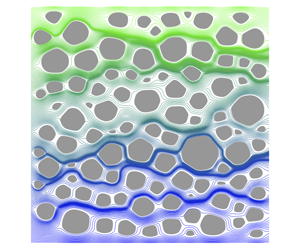Crossref Citations
This article has been cited by the following publications. This list is generated based on data provided by
Crossref.
Christlieb, Andrew J.
Guthrey, Pierson T.
Sands, William A.
and
Thavappiragasm, Mathialakan
2021.
Parallel Algorithms for Successive Convolution.
Journal of Scientific Computing,
Vol. 86,
Issue. 1,
Mo, Chaojie
Johnston, Richard
Navarini, Luciano
and
Ellero, Marco
2021.
Modeling the effect of flow-induced mechanical erosion during coffee filtration.
Physics of Fluids,
Vol. 33,
Issue. 9,
Mo, Chaojie
Navarini, Luciano
Liverani, Furio Suggi
and
Ellero, Marco
2022.
Modeling swelling effects during coffee extraction with smoothed particle hydrodynamics.
Physics of Fluids,
Vol. 34,
Issue. 4,
McCurdy, Matthew
Moore, Nicholas J.
and
Wang, Xiaoming
2022.
Predicting convection configurations in coupled fluid–porous systems.
Journal of Fluid Mechanics,
Vol. 953,
Issue. ,
Mac Huang, Jinzi
and
Moore, Nicholas J.
2022.
Morphological Attractors in Natural Convective Dissolution.
Physical Review Letters,
Vol. 128,
Issue. 2,
Xu, Donghai
Feng, Peng
Wang, Yang
Yang, Wanpeng
Wang, Yu
and
Sun, Shaoyan
2022.
Effects of structural parameters on water film properties of transpiring wall reactor.
AIChE Journal,
Vol. 68,
Issue. 2,
Bayat, Elyce
Egan, Raphael
Bochkov, Daniil
Sauret, Alban
and
Gibou, Frederic
2022.
A sharp numerical method for the simulation of Stefan problems with convective effects.
Journal of Computational Physics,
Vol. 471,
Issue. ,
p.
111627.
Cherry, Jake
Lindsay, Alan E.
Navarro Hernández, Adrián
and
Quaife, Bryan
2022.
Trapping of Planar Brownian Motion: Full First Passage Time Distributions by Kinetic Monte Carlo, Asymptotic, and Boundary Integral Methods.
Multiscale Modeling & Simulation,
Vol. 20,
Issue. 4,
p.
1284.
Moore, Nicholas J.
Cherry, Jake
Chiu, Shang-Huan
and
Quaife, Bryan D.
2023.
How fluid-mechanical erosion creates anisotropic porous media.
Physica D: Nonlinear Phenomena,
Vol. 445,
Issue. ,
p.
133634.
Mo, Chaojie
Johnston, Richard
Navarini, Luciano
Liverani, Furio Suggi
and
Ellero, Marco
2023.
Exploring the link between coffee matrix microstructure and flow properties using combined X-ray microtomography and smoothed particle hydrodynamics simulations.
Scientific Reports,
Vol. 13,
Issue. 1,
Sun, Hui
and
Moore, Nicholas J.
2023.
On Normal and Non-Normal Wave Statistics Implied by a Canonical–Microcanonical Gibbs Ensemble of the Truncated KdV System.
Journal of Statistical Physics,
Vol. 190,
Issue. 1,
Zeng, Jia
and
Moore, Nicholas J.
2024.
A Computational Framework for the Administration of 5-Aminovulinic Acid Before Glioblastoma Surgery.
Bulletin of Mathematical Biology,
Vol. 86,
Issue. 7,
Kahza, Hamad El
and
Sanaei, Pejman
2024.
Mathematical modeling of erosion and deposition in porous media.
Physical Review Fluids,
Vol. 9,
Issue. 2,
Mazi, Emeka Peter
El Kahza, Hamad
and
Sanaei, Pejman
2024.
Mathematical modeling of deposition and erosion in porous media with branching channels.
Physical Review Fluids,
Vol. 9,
Issue. 11,
Sims, Amy María
Kunnatha, Sai
Mazi, Emeka Peter
Joseph, Priyanka
Saber, Kulsum
Hwang, Daniel
and
Sanaei, Pejman
2024.
Simplified mathematical model for erosion and deposition in a porous medium.
Physical Review Fluids,
Vol. 9,
Issue. 12,
Cheng, Zhi
Lien, Fue-Sang
Zhang, Ji Hao
and
Gu, Grace X.
2024.
Blind zones in radiating dispersion at high Péclet number driven by non-Newtonian fluids in porous media.
Journal of Fluid Mechanics,
Vol. 986,
Issue. ,
Feriadi, Yusron
Arbie, Muhammad Rizqie
Fauzi, Umar
and
Fariduzzaman
2024.
Pore-scale simulation of flow in porous rocks for wall shear stress analysis.
Modeling Earth Systems and Environment,
Vol. 10,
Issue. 4,
p.
4877.
Dalla Barba, Federico
and
Picano, Francesco
2025.
Direct numerical simulations of the breakup of porous media in laminar duct flow.
Meccanica,
Vol. 60,
Issue. 8,
p.
2451.
Cherry, Jesse
Lindsay, Alan E.
and
Quaife, Bryan D.
2025.
Boundary integral methods for particle diffusion in complex geometries: Shielding, confinement, and escape.
Journal of Computational Physics,
Vol. 534,
Issue. ,
p.
114032.
Christlieb, Andrew J.
Sands, William A.
and
White, Stephen R.
2025.
A Particle-in-Cell Method for Plasmas with a Generalized Momentum Formulation, Part I: Model Formulation.
Journal of Scientific Computing,
Vol. 103,
Issue. 1,


